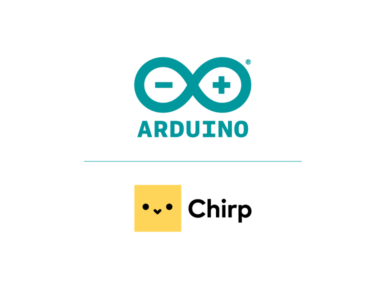
IR receiver sensor
Very sensitive IR sensor with preamplifier, demodulator, and filter calibrated to the frequency of 38 kHz - 600 µs, with built-in amplifier/squarer.
Overview
It has only three terminals and operates on 5 V power supply.
Vdd= + 5 Vdc, GND= ground, OUT= TTL signal output
Tech specs
- Output: active at low level (0.2 V)
- Power supply: 4.5 V ~ 5.5 V
- Power consumption: 0.6 mA
- Wavelength: 940 nm
- BPF center frequency: 38 kHz
- Operating temperature: -10°C ~ +60°C
- Signal range: max. 10 m
- Dimensions: 7.3 x 7.6 x 5.2 mm
- Weight: 0.68 g
Get Inspired
In this tutorial, you'll learn how to connect your Arduino MKR NB 1500 board securely to Microsoft Azure IoT Hub.

We are excited to announce a new partnership with Chirp, a London-based company on a mission to simplify connectivity using sound. Chirp’s machine-to-machine communications software enables any device with a loudspeaker or microphone to exchange data via inaudible sound waves. Starting today, our Chirp integration will allow Arduino-powered projects to send and receive data wirelessly over sound waves, using just microphones and loudspeakers. Thanks to some compatible libraries included in the official Arduino Library Manager and in the Arduino Create — as well as further comprehensive documentation, tutorials and technical support — it will be easy for anyone to add data-over-sound capabilities to their Arduino projects. Our new Nano 33 BLE Sense board, with a DSP-optimised Arm Cortex-M4 processor, will be the first board in the Arduino range with the power to transmit and receive Chirp audio signals leveraging the board's microphone as a receiver. From now on, the Chirp SDK for Arduino will support the following boards in send-only mode: Arduino MKR Zero, Arduino MKR Vidor 4000, Arduino MKR Fox 1200, Arduino MKR WAN 1300, Arduino MKR WiFi 1010, Arduino MKR GSM 1400, Arduino MKR NB 1500 and the Arduino Nano 33 IoT. Creative applications of Arduino and Chirp include, but certainly are not limited to: Triggering events from YouTube audioSecurely unlocking a smart lock with sound Sending Wi-Fi credentials to bring offline devices onto a Wi-Fi networkHaving a remote control that only interacts with the gadgets in the same room as you “Connectivity is a fundamental asset for our users, as the demands of IoT uptake require devices to communicate information seamlessly and with minimal impact for the end user. Chirp’s data-over-sound solution equips our boards with robust data transmission, helping us to deliver enhanced user experiences whilst increasing the capabilities of our hardware at scale,” said Massimo Banzi, Arduino co-founder.





